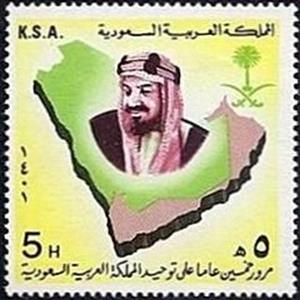Stamp: King Abdul Aziz (Saudi Arabia 1981)
King Abdul Aziz (Saudi Arabia 1981)
23 September (Saudi Arabia ) within release 50th Anniv. Of Kingdom. goes into circulation Stamp King Abdul Aziz face value 5 Saudi halala
| Stamp King Abdul Aziz in catalogues | |
|---|---|
| Michel: | Mi:SA 702 |
| Stamp Number: | Sn:SA 825 |
| Yvert et Tellier: | Yt:SA 530 |
Stamp is square format.
Also in the issue 50th Anniv. Of Kingdom.:
- Stamp - King Abdul Aziz face value 5;
- Stamp - King Abdul Aziz face value 10;
- Stamp - King Abdul Aziz face value 15;
- Stamp - King Abdul Aziz face value 20;
- Stamp - King Abdul Aziz face value 50;
- Stamp - King Abdul Aziz face value 65;
- Stamp - King Abdul Aziz face value 80;
- Stamp - King Abdul Aziz face value 115;
- Souvenir Sheet - King Abdul Aziz face value 10;
Stamp King Abdul Aziz it reflects the thematic directions:
A head of state (or chief of state) is the public persona that officially represents the national unity and legitimacy of a sovereign state. In some countries, the head of state is a ceremonial figurehead with limited or no executive power, while in others, the head of state is also the head of government. In countries with parliamentary governments, the head of state is typically a ceremonial figurehead that does not actually guide day-to-day government activities and may not be empowered to exercise any kind of secular political authority (e.g., Queen Elizabeth II as Head of the Commonwealth). In countries where the head of state is also the head of government, the president serves as both a public figurehead and the actual highest ranking political leader who oversees the executive branch (e.g., the President of the United States).
A map is a symbolic depiction emphasizing relationships between elements of some space, such as objects, regions, or themes. Many maps are static, fixed to paper or some other durable medium, while others are dynamic or interactive. Although most commonly used to depict geography, maps may represent any space, real or imagined, without regard to context or scale, such as in brain mapping, DNA mapping, or computer network topology mapping. The space being mapped may be two dimensional, such as the surface of the earth, three dimensional, such as the interior of the earth, or even more abstract spaces of any dimension, such as arise in modeling phenomena having many independent variables. Although the earliest maps known are of the heavens, geographic maps of territory have a very long tradition and exist from ancient times. The word "map" comes from the medieval Latin Mappa mundi, wherein mappa meant napkin or cloth and mundi the world. Thus, "map" became the shortened term referring to a two-dimensional representation of the surface of the world.
King is the title given to a male monarch in a variety of contexts. The female equivalent is queen regnant (while the title of queen on its own usually refers to the consort of a king). In the context of prehistory, antiquity and contemporary indigenous peoples, the title may refer to tribal kingship. Germanic kingship is cognate with Indo-European traditions of tribal rulership (c.f. Indic rājan, Gothic reiks, and Old Irish rí, etc.) In the context of classical antiquity, king may translate Latin rex or either Greek archon or basileus. In classical European feudalism, the title of king as the ruler of a kingdom is understood as the highest rank in the feudal order, potentially subject, at least nominally, only to an emperor (harking back to the client kings of the Roman Empire). In a modern context, the title may refer to the ruler of one of a number of modern monarchies (either absolute or constitutional). The title of king is used alongside other titles for monarchs, in the West prince, emperor, archduke, duke or grand duke, in the Middle East sultan or emir; etc. Kings, like other royalty, tend to wear purple because purple was an expensive color to wear in the past.



